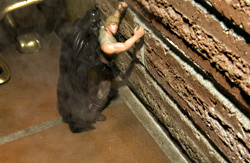AMY LEE IS a research technologist at the University of Washington with 19 years under her belt. Some officials at UW now wonder what all that experience has taught her. That’s because four months ago, she did something very sloppy or very stupid. Either way, it led university officials to take the extremely rare step of suspending research—and of blocking both her and her boss, a 35-year UW employee, from doing any further work with research animals.
Even worse, Lee could have exposed people on an airliner to bacteria that causes pneumonia and is believed by some researchers to play a role in cardiovascular disease.
“No one here is going to say there were not violations—there were,” says David Eaton, associate dean of research at the university’s School of Public Health.
Research techs, as they are known, are the grunt workers of science. They run everything from laboratory centrifuges to computer sampling programs. In labs using animals as research vehicles, techs are often charged with handling sick mice and rats and euthanizing the animals at the end of an experiment. According to a series of letters between UW officials and the National Institutes of Health (NIH), on Feb. 1 Lee was instructed to euthanize a batch of sick mice.
The mice had purposely been infected with Chlamydia pneumoniae, which is not the better-known sexually transmitted disease but a respiratory bacterium that causes an estimated 10 percent of pneumonia cases. Some researchers believe that Chlamydia pneumoniae may even be linked to atherosclerosis, the narrowing of an artery. The mice were part of a study by Cho-chou Kuo, a UW pathobiology professor, testing that link.
Because the mice carried an infectious illness, federal law required them to be kept in a special bio-safety room at the Warren G. Magnuson Health Sciences Building on the UW campus. Techs were also supposed to wear protective gowns when handling the animals. But an ungowned Lee took the mice into a room that wasn’t equipped to handle the bacteria, according to Melvin Dennis, chair of UW’s Department of Comparative Medicine. She asked another tech to kill the mice. That didn’t happen.
It is not clear exactly when, but according to university officials, sometime during the next two days Lee opened the mice cage, potentially exposing herself and anyone in the room to bacteria that the Centers for Disease Control ranks alongside Legionnaires’ disease (the mice were euthanized later that week). Then she boarded a plane for a weeklong trip.
“Before we found out what was going on, she was on a plane to Hong Kong,” says Dennis. He also sits on the university’s Institutional Animal Care and Use Committee (IACUC); the committee oversees all animal research on campus.
“We had three or four days of unknowns” after that, says Michael Antee, supervisor of UW’s Environmen-tal Health and Safety. He says it was a week before anyone could tell if the university was dealing with a nasty bacteriological problem.
It wasn’t. But Lee and Kuo’s troubles were just beginning to spread.
ON FEB. 21, UW’s IACUC met. It is a 14-member committee composed almost entirely of UW researchers. Its purpose is to approve or disapprove research that uses animals on campus and to ensure that the animals—typically mice and rats—are treated humanely. Part of its charge is to ensure that all research is done according to a complex series of federal laws, including National Institutes of Health rules on handling of bacteria.
Before undertaking animal work, researchers must submit a research protocol to IACUC. If it is approved, no deviations from the protocol are allowed.
The IACUC was not amused by what it learned on Feb 21. Kuo and his tech had violated approved research protocol by mishandling the mice and creating the potential for spreading aggressive bacteria.
“It was a violation of the procedures,” says Dennis.
Besides, this wasn’t Kuo’s first brush with the IACUC. Since 1999, the committee had twice slapped him with warnings for skirting protocols.
A warning was not in the cards this day. Instead, the committee suspended Kuo’s research for a minimum of six months. As Dennis later explained in a letter to NIH, Kuo “created an atmosphere that sanctioned the technician’s actions.”
Susanna Cunningham, chair of the IACUC, says she can recall fewer than 10 instances of research suspensions during her 20 years on the committee.
On top of the suspension, Kuo and Lee were both banned from working with research animals. At its May 16 meeting, the IACUC reinforced the suspension and the ban.
Although she’s diplomatic about it, Cunningham is clearly torqued about the affair. She says that if IACUC hadn’t caught up with Kuo and Lee, then any arm of the federal government’s vast animal research enforcement machine could have hammered UW, potentially suspending payments to the university. That would have effectively shut down some research.
She and Dennis both acknowledge that Kuo may have tried to get around the suspension by writing to NIH. In a Feb. 28 letter to the agency, Kuo wrote that he could shuffle his research off onto other researchers and technicians. Two weeks later, an NIH official wrote Dennis and asked that he assure the agency that Kuo was not trying to circumvent the suspension.
The university has taken no further action against Kuo and Lee. David Eaton, the associate research dean, calls Kuo “one of our most upstanding citizens.” He attributes the incident to a poor judgment call on Lee’s part.
Kuo declined comment for this article. But in a prepared statement, he says that he plans to petition IACUC to reauthorize his research and permit him to work with animals again. The earliest the committee will consider his request is mid-August.
Lee, who didn’t contract the bacteria, was unavailable for comment.








